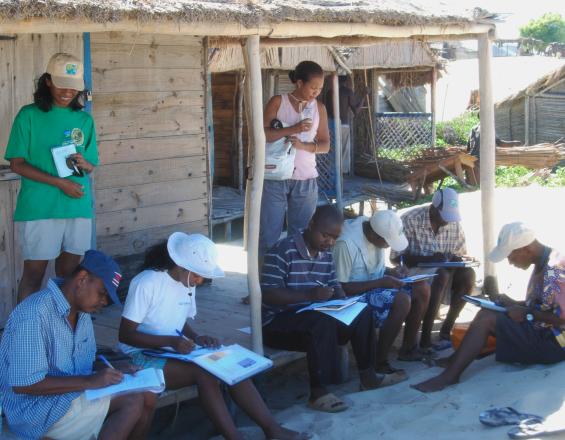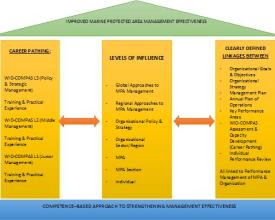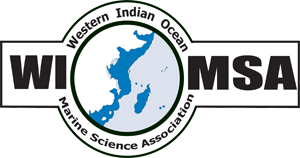Desarrollo de capacidades basado en competencias para una gestión eficaz de las AMP

Océano Índico Occidental - Certificación de Profesionales de Áreas Marinas Protegidas (WIO-COMPAS) es un enfoque basado en competencias para el desarrollo de capacidades individuales y organizativas con el fin de abordar el problema de la gestión ineficaz de las AMP en la región, principalmente para las agencias de conservación encargadas de esta tarea. Hasta la fecha ha certificado a 68 profesionales de AMP en 8 países y se ha integrado en la gestión de recursos humanos de 2 agencias, el Servicio de Vida Silvestre de Kenia y, en Sudáfrica, CapeNature.
Contexto
Défis à relever
- Gestión ineficaz de las AMP
- Competencia limitada del personal de las AMP
- Falta de personal dedicado a la AMP y de perspectivas de carrera para los profesionales de la AMP
- Recursos limitados
- Colaboración limitada dentro de las agencias y entre ellas
- Falta de comprensión de las AMP en organismos y gobiernos
- Creciente presión sobre los recursos marinos
- Aumento de las presiones políticas para que las comunidades se beneficien de los recursos marinos y las AMP.
Ubicación
Procesar
Resumen del proceso
- Las competencias son la base de todo el proceso, sobre la que se construye todo lo demás.
- Los instrumentos y herramientas de evaluación son los medios por los que se evalúa la competencia de los individuos con respecto a las competencias. De este modo se determina su nivel real de competencia, se identifican las lagunas que requieren un refuerzo de las capacidades y se identifica a las personas con un potencial especial de promoción profesional. Por tanto, junto con las competencias, constituyen el marco de la trayectoria profesional de la columna de la izquierda.
- Los eventos de certificación proporcionan reconocimiento profesional al personal competente y establecen puntos de referencia claros para el desarrollo profesional y los Indicadores Clave de Rendimiento. En última instancia, fijan la norma de la capacidad individual, de equipo y organizativa para cumplir el mandato con eficacia.
- La institucionalización integra todos los pilares anteriores en un enfoque coherente e integrado de la gestión de recursos humanos para la eficacia de la gestión.
Bloques de construcción
Requisitos críticos de competencia
El propósito es identificar los requisitos de competencia críticos para un funcionamiento eficaz en todos los niveles. Los niveles están estrechamente relacionados entre sí, ya que tienen las mismas áreas de competencia (véase más abajo) y muchas de las competencias que las componen demuestran una progresión en las capacidades y los conocimientos a lo largo de los niveles. Algunas competencias son específicas de determinados niveles. Las competencias se utilizan para
- Establecer puntos de referencia para las operaciones en los tres niveles.
- Proporcionar criterios rigurosos para la certificación profesional.
- Informar sobre la evaluación de las competencias existentes e identificar lagunas en las competencias.
- Informar sobre las necesidades de formación y otras intervenciones de desarrollo de capacidades
- Certificar como AMP-PRO al personal de AMP que cumpla los requisitos de competencia.
- Informar los procesos de contratación, revisión del desempeño y promoción
- Establecer una trayectoria profesional para el personal de AMP
- Configurar la formación impartida al personal de AMP
Las competencias se agrupan en 7 "Áreas de competencia":
- Política, legislación y cumplimiento
- Concepto y establecimiento de AMP
- Comunicación y participación de las partes interesadas
- Gestión financiera y recaudación de fondos
- Operaciones de gestión
- Entorno biofísico y sociocultural
- Liderazgo, ética e innovación
Factores facilitadores
- Enfoque inicial en un nivel
- Listas de competencias elaboradas en colaboración con la participación de diversas perspectivas: gestión de (M)PA; ciencia; educación y evaluación
- Competencias agrupadas en áreas de competencia
- Competencias suficientemente genéricas para ser ampliamente aplicables
- Competencias a un nivel bastante amplio en el que cada competencia abarca una serie de aptitudes específicas
- Competencias limitadas a menos de 80 (máximo absoluto) para facilitar una evaluación eficaz
- Competencias respaldadas por declaraciones de rango que indiquen el nivel requerido y las pruebas pertinentes para su evaluación
Lección aprendida
La lección principal es que la identificación de las competencias debe ser un proceso colaborativo e iterativo. No aparecen de la noche a la mañana y requieren una atención constante durante un tiempo considerable. Las diferentes perspectivas son esenciales, pero llevarán el proceso en direcciones diferentes, y el resultado final representará inevitablemente una especie de compromiso. El punto de partida deberían ser probablemente las áreas de competencia (véanse las listas de competencias de WIO-COMPAS en el Manual). La concentración inicial en un nivel fue una característica importante del proceso, ya que evitó la complicación de intentar trabajar en todos los niveles a la vez. Nunca se insistirá demasiado en que el proceso de identificación de las competencias es absolutamente central en todo el proceso, y las competencias son la base de todo lo que sigue.
Herramientas e instrumentos de certificación
La identificación de los medios más adecuados para evaluar las diferentes competencias requiere el desarrollo de una serie de "instrumentos" de evaluación que ofrezcan diversas oportunidades para demostrar las competencias. Los instrumentos deben ser apropiados tanto para el tipo de habilidad o comprensión que se evalúa como para el nivel en el que se realiza la evaluación. Los instrumentos utilizados por WIO-COMPAS son:
- Formulario de solicitud para la evaluación inicial (todos los niveles)
- Portafolio de evidencias compuesto por documentos producidos en el lugar de trabajo (todos los Niveles)
- Documento de actividad principal/estudio de caso (todos los Niveles)
- Demostración práctica a través de escenarios (Nivel 1)
- Prueba escrita, basada en imágenes proyectadas de especies clave (Nivel 1); Prueba escrita (Nivel 2)
- Entrevista cara a cara (Niveles 1 y 2); Entrevista en panel (Nivel 3)
Desarrollar un sistema y unas "herramientas" asociadas que permitan puntuar las competencias evaluadas. En WIO-COMPAS las competencias más importantes tienen una ponderación de una posible puntuación de 4 puntos, mientras que las demás tienen una ponderación de 2 puntos. Se utiliza una hoja de puntuación para cada instrumento, y las puntuaciones se transfieren a un "paquete de puntuación de candidatos" basado en Excel.
Factores facilitadores
- Desarrollado por un equipo con un sólido conocimiento "tácito" del sector a todos los niveles.
- Inclusión de especialistas en educación y evaluación
- Establecimiento de criterios claros para la obtención de la certificación
- Reconocimiento del proceso como esencialmente un proceso de desarrollo y mejora de la capacidad, para todos, incluidos los que obtienen la certificación.
Lección aprendida
Es fundamental reconocer las diferencias en las funciones y actividades que se realizan en los distintos niveles, así como los distintos requisitos de las capacidades de comunicación escrita y oral en estos niveles. Por lo tanto, los instrumentos deben adecuarse a las funciones laborales diarias en los distintos niveles. Deben ofrecerse oportunidades adecuadas para que los candidatos a la certificación demuestren sus competencias. Un instrumento no es suficiente, ya que puede favorecer a unos candidatos en detrimento de otros. El concepto clave es el de "evidencia", que los instrumentos están diseñados para obtener de los candidatos. Un sistema de puntuación es esencial, ya que proporciona una medida rigurosa de las evaluaciones y de la solidez de las pruebas presentadas a través de los distintos instrumentos por los candidatos. Los enunciados de rango asociados a cada competencia son vitales para garantizar la coherencia en la evaluación y en la puntuación de las pruebas entre los evaluadores.
Actos de certificación
Este elemento se refiere al establecimiento de un proceso para el uso de los instrumentos y herramientas en la evaluación de la competencia de los profesionales y su idoneidad para la certificación. Dicho proceso se conoce en WIO-COMPAS como "evento", y comienza con una convocatoria de solicitudes de profesionales adecuados que trabajen en el nivel apropiado para el nivel de certificación en el que se centre el evento. El proceso de solicitud proporciona una selección inicial para garantizar, en la medida de lo posible, que los solicitantes tienen una posibilidad muy razonable de obtener la certificación. Los solicitantes que aprueban se convierten en "candidatos" y son invitados a un evento de cuatro días en el que evaluadores experimentados utilizan los instrumentos de evaluación interactivos. Antes de la prueba, los candidatos elaboran las carpetas de trabajo y los casos prácticos. Tras un riguroso proceso de selección y formación, se nombra a los evaluadores y, en los niveles 1 y 2, a cada uno de ellos se le asignan 3 ó 4 candidatos, a los que guían a lo largo del proceso. En el nivel 3, los evaluadores trabajan conjuntamente en un panel. La decisión final sobre la certificación de un candidato no corresponde a los evaluadores, sino a la Junta de Certificación, que actúa sobre la base de sus recomendaciones.
Factores facilitadores
- Nombramiento de evaluadores con la experiencia, cualificación y formación adecuadas, con un buen conocimiento tácito del campo y/o de los procesos de evaluación.
- Que los evaluadores actúen como mentores y no como jueces.
- Inclusión de un proceso de solicitud riguroso
- Directrices claras sobre todos los aspectos del proceso para los solicitantes/candidatos.
- Inclusión de un proceso de apelación claro para los candidatos insatisfechos
- Red establecida y de confianza a la que los organismos certificadores pueden acceder para que las organizaciones participantes envíen a su personal a los eventos.
Lección aprendida
La calidad y el compromiso de los evaluadores son primordiales. La relación entre evaluadores y candidatos debe ser a la vez colegiada y disciplinada, manteniendo la distancia necesaria y proporcionando el apoyo necesario. En WIO-COMPAS se ha acordado que, preferiblemente, los evaluadores no pertenezcan a la misma institución que ninguno de sus candidatos. Mientras que un solo evaluador puede tener capacidad suficiente para evaluar en los niveles 1 y 2, la evaluación del nivel 3 requiere un grupo de especialistas que trabajen de forma concertada. Los evaluadores, aunque tengan responsabilidad individual sobre un grupo de candidatos (excepto en el Nivel 3), deben interactuar frecuentemente entre ellos y compartir los progresos de sus candidatos. En última instancia, las recomendaciones de certificación o no, se presentan como una decisión colectiva. Debe preverse tiempo suficiente para cada etapa del proceso, desde las solicitudes iniciales hasta la aplicación de todos los instrumentos en el acto.
Impactos
Se han realizado impactos en:
A nivel individual, con 68 MPA-PRO certificados. En una encuesta realizada en 2012
- El 90 % de los PRO de nivel 1 y el 80 % de los de nivel 2 afirmaron haber adquirido más confianza en la ejecución de sus funciones
- El 90 % de los profesionales de nivel 1 y el 60 % de los de nivel 2 afirmaron que el proceso había mejorado su capacidad de gestión de las AMP.
A nivel organizativo, con 2 grandes agencias de conservación:
- La nueva política de RRHH del Kenya Wildlife Service ha incorporado el concepto de certificación.
- Uno de los 9 meses de formación de guardabosques del KWS se centra ahora en las AMP.
- Se está elaborando un plan de estudios completo sobre AMP para el KWS.
- El director general de CapeNature habló en el WPC en 2014 en pleno apoyo del proceso de institucionalización del programa en su organización, recomendando encarecidamente esto a otras agencias
A nivel regional:
- El 90% de los profesionales de nivel 1 y el 93% de los de nivel 2 afirmaron que WIO-COMPAS había influido en cierta medida o en gran medida en la conservación marina de la región
Nivel mundial:
- El Programa de Desarrollo de Capacidades de la UICN-CMAP cita a WIO-COMPAS como modelo para la certificación basada en competencias y el desarrollo de capacidades.
Beneficiarios
Personal de las AMP, agencias/organizaciones gestoras, gobiernos, pescadores y otros recolectores de recursos marinos, comunidad científica.
Historia
En Kenia, el medio costero y marino es fundamental para la supervivencia de las especies y los seres humanos, ya que ofrece una amplia gama de servicios ecosistémicos. Entre ellos figuran servicios de aprovisionamiento, como la alimentación, y servicios socioculturales, como el turismo, que aporta cerca del 12% del PIB de Kenia. Para gestionar adecuadamente los recursos marinos y costeros y garantizar la supervivencia de las especies y la prestación continua de servicios ecosistémicos, es fundamental contar con profesionales competentes que posean una amplia gama de competencias y capacidades. Arthur Tuda es uno de esos profesionales con amplia experiencia en conservación marina en Kenia. El Sr. Tuda trabaja como gestor regional supervisando las zonas costeras protegidas de Kenia que dependen del Servicio de Vida Silvestre de Kenia. Está a cargo de cinco áreas marinas protegidas (AMP) y seis parques terrestres, y supervisa a una plantilla de más de 350 personas que trabajan en estas zonas protegidas. La responsabilidad que tiene el Sr. Tuda no se da a la ligera. Se la ha ganado a pulso, demostrando sus dotes de liderazgo y capacidad de trabajo en parte mediante la certificación como MPA PRO (Marine Protected Area-Professional) en la Certificación de Profesionales de Áreas Marinas Protegidas del Océano Índico Occidental (WIO-COMPAS). Tuda atribuye a su experiencia como MPA PRO el haber reforzado su confianza y competencia en su campo profesional. En 2008, pasó a ser director de sitio. Fue el primer keniano en lograr la Certificación de Gestión de Sitios de Nivel 2. Sigue siendo un líder activo con MPA PRO al convertirse en evaluador de Nivel 1 y Nivel 2. En esta función evalúa la capacidad de otros profesionales de AMP de África Oriental que esperan obtener la certificación de nivel 1 y 2. En 2012 demostró su compromiso con el valor del programa al obtener la certificación de nivel 3 en Estrategia, Política y Planificación. A principios de 2013 fue ascendido al puesto de subdirector que ocupa ahora. Hoy en día, mientras el Sr. Tuda supervisa más de 2.500 kilómetros cuadrados de hábitat crítico, utiliza lo que ha aprendido como PRO de AMP para asumir los retos de gestionar áreas de conservación expansivas con recursos y personal limitados. Constantemente prueba nuevas ideas, mejora estrategias y trabaja para mantener motivado a su personal. Y comparte su experiencia certificada como MPA PRO todos los días asesorando a su personal, lo que considera una de las partes favoritas de su trabajo. Igualmente importante es el papel de liderazgo que ha asumido en WIO-COMPAS para promover el valor de la certificación AMP PRO.



